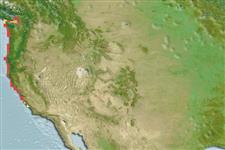>
Ovalentaria/misc (Various families in series Ovalentaria) >
Embiotocidae (Surfperches)
Etymology: Amphistichus: Greek, amphi = on both sides + Greek, stix, -ichos = row (Ref. 45335); rhodoterus: From 'rodoteros' meaning rosy (Ref. 6885).
More on author: Agassiz.
Environment: milieu / climate zone / depth range / distribution range
Ecologia
marino; salmastro demersale; distribuzione batimetrica 0 - 7 m (Ref. 2850). Temperate; 50°N - 34°N, 126°W - 119°W
Eastern Pacific: Vancouver Island, British Columbia, Canada to Avila Beach, central California, USA.
Size / Peso / Age
Maturity: Lm ? range ? - ? cm
Max length : 41.0 cm TL maschio/sesso non determinato; (Ref. 2850); Età massima riportata: 9 anni (Ref. 56049)
Short description
Chiavi di identificazione | Morfologia | Morfometria
Spine dorsali (totale) : 9 - 10; Raggi dorsali molli (totale) : 25 - 28; Spine anali: 3; Raggi anali molli: 28 - 31. Caudal fin broadly forked (Ref. 6885). Generally silvery overlaid lightly with a brassy cast; light green above; sides with a series of about 9 to 11 narrow vertical dark bars, posteriorly, broken and staggered along the lateral line; caudal and anal fins red (Ref. 6885).
Adults are found in sand beaches in surf on exposed coast, sometimes in bays and backwaters (Ref. 2850). Viviparous, female carries the developing young (Ref. 205).
Life cycle and mating behavior
Maturità | Riproduzione | Deposizione | Uova | Fecundity | Larve
Viviparous, female carries the developing young (Ref. 205).
Eschmeyer, W.N., E.S. Herald and H. Hammann, 1983. A field guide to Pacific coast fishes of North America. Boston (MA, USA): Houghton Mifflin Company. xii+336 p. (Ref. 2850)
IUCN Red List Status (Ref. 130435: Version 2024-1)
Threat to humans
Harmless
Human uses
Pesca: commerciale; Pesce da pesca sportiva: si; Acquario: Acquari pubblici
Strumenti
Special reports
Download XML
Fonti Internet
Estimates based on models
Preferred temperature (Ref.
123201): 10.3 - 14, mean 12.1 °C (based on 57 cells).
Phylogenetic diversity index (Ref.
82804): PD
50 = 0.6250 [Uniqueness, from 0.5 = low to 2.0 = high].
Bayesian length-weight: a=0.01413 (0.00848 - 0.02352), b=3.00 (2.85 - 3.15), in cm total length, based on LWR estimates for this species & (Sub)family-body (Ref.
93245).
Trophic level (Ref.
69278): 3.4 ±0.5 se; based on diet studies.
Resilienza (Ref.
120179): Medio, tempo minimo di raddoppiamento della popolazione 1.4 - 4.4 anni (tm=3; tmax=9; Fec=39).
Fishing Vulnerability (Ref.
59153): Low to moderate vulnerability (31 of 100).
